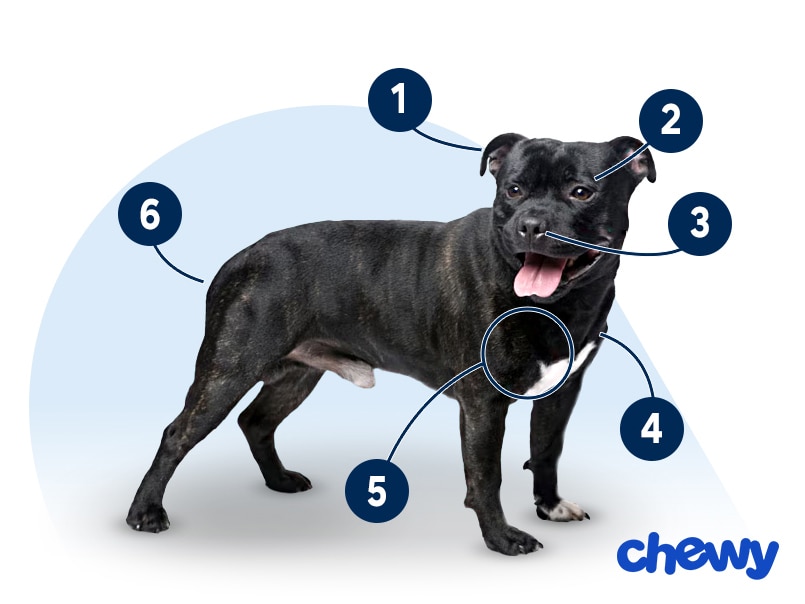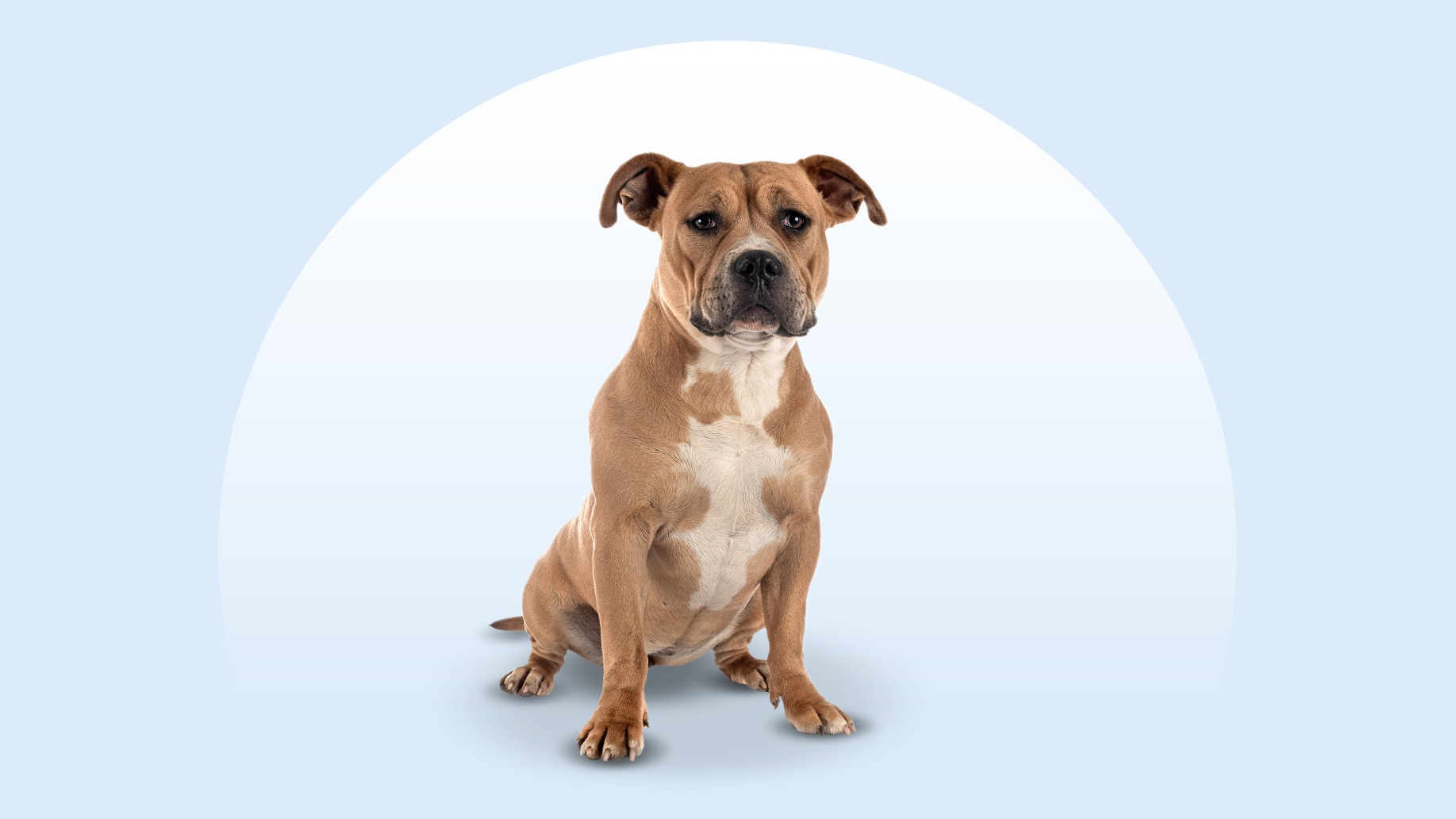Staffordshire Bull Terrier
Updated June 4, 2025
Staffordshire Bull Terrier
Updated June 4, 2025
Affectionately referred to as “land seals,” Staffordshire Bull Terriers are thrilled to be your best friend. These friendly canines have a reputation for their tendency to dote on little kids, and their big smiles show how much they love being part of the family.
Doting, Playful, Silly
24–38 pounds
14–16 inches
12–14 years
Black, Black And White, Blue, Blue And White, Brindle, Brindle And White, Fawn, Fawn And White, Red, Red And White, White, White And Brindle, White And Fawn, White And Red
Concerned that a seal has moved into your neighborhood and you might need to call a wildlife rescue? Don’t worry—if they were a medium-sized short stack with four legs, it was just a Staffordshire Bull Terrier, aka a “land seal.”
These cute canines have velvety fur, a seal-like black nose, and huge, dark eyes that make you think they should be sunning on a rock somewhere. And when their ears are back, it’s nearly impossible to tell who’s a dog and who’s a seal.
When a Staffordshire Bull Terrier, or “Staffy” for short, decides to smile, you’ve never seen a bigger grin in your life. That’s the giveaway that this creature is a loyal and friendly BFF who prefers life on the sofa instead of life at sea.
Staffordshire Bull Terrier Characteristics
Staffordshire Bull Terrier Appearance
Staffordshire Bull Terriers may be smaller than their relatives, the American Staffordshire Terrier, but they’re just as athletic and agile. Staffies have a wide grin that makes them look like the happiest dogs on the planet, and their bright, eager eyes reflect their curiosity and kindness.

- Ears
These dogs have small- to medium-size ears that are either alert and folded slightly back (known as a rose shape) or alert and folded forward at the top (known as half-pricked).
- Eyes
Staffies have dark, round, medium-size eyes with a bright, intelligent expression.
- Nose
They have a relatively short muzzle with a black nose.
- Coat Length
They have a sleek, short coat that’s close to the skin. It’s often called glossy or velvet.
- Coat Color
Staffy colors might be black, blue, red, fawn, red, brindle (faint tiger-like stripes), or any of these colors with or without white patterns.
- Tail
Their tail is usually medium-length and low-set.
Staffordshire Bull Terrier Temperament
If you’re looking for a best friend who thinks you’re the best thing since sliced bread, well, you’ve found them. The Staffy is a loyal, devoted pal who wiggles their whole body when wagging their tail.
Staffy dogs are extremely bright and buzzy with energy. Although they’ll definitely enjoy their couch time, they also enjoy being part of an active family—whether it’s hikes, walks, fun games, scent work, or dog sports like agility trials.
These canines love people, so they’re often delighted to be introduced to someone new. But for them to be their best self, a Staffy needs early (and consistent!) socialization when they’re younger so they grow into a calm and open adult.
When it comes to other pets, some Staffies might want to be your one and only. But each dog’s an individual, and others might enjoy two- and four-legged siblings, especially when introductions are made properly.
In fact, Staffordshire Bull Terriers are often called The Nanny Dog because of how much they enjoy the company of children.
How to Care for a Staffordshire Bull Terrier
These clever canines don’t require a lot of grooming time. But a Staffy’s smarts mean lots of mental stimulation is a must, and they’ll love putting their brain to work during obedience training sessions.
Grooming
Training
Diet
Exercise
Environment
Staffordshire Bull Terrier Health
The typical Staffordshire Bull Terrier lifespan is 12–14 years. Here are a few health issues to be aware of.
- Cataracts: Cataracts are a common eye problem and can be hereditary in Staffy puppies. Surgery is the go-to treatment.
- Degenerative myelopathy: This is a neurological disease that affects the spinal cord, causing problems with breathing, vocalizing, and eating. DM it slowly weakens and then paralyzes the back legs. There is no treatment to reverse it, but physical therapy may help.
- Elbow and hip dysplasia: Elbow and hip dysplasia are genetic conditions that develop during puppyhood when the joints don’t align well and become looser than normal. Signs include limping, and treatment might involve weight loss, reduced activity, joint supplements, physical therapy, pain meds, or, in severe cases, surgery.
- L-2-hydroxyglutaric aciduria: A rare, genetic metabolic condition, this disorder may cause seizures, a wobbly gait (ataxia), dementia, and tremors. There’s no cure, but anticonvulsants may be used to treat it.
Staffordshire Bull Terrier History
The Staffordshire Bull Terrier has an admittedly sad origin story. They were first bred in England to be used in dog sports. People would bet on these events, and breeds from Staffordshire Bull Terriers to English Bulldogs were used for things like bull baiting, which was outlawed in 1835.
Sadly, though, the law just drove any activity underground, and dogfighting became popular.
To be clear: Dogs like Staffies and Pit Bulls were often used in fighting not because they are naturally mean—on the contrary, their loyalty and desire to please their human made them very malleable.
However, the Staffordshire Bull Terrier and related breeds were unfoundedly were maligned by the media, which caused a drop in their popularity. There is still prejudice against the dogs, including breed-specific legislation, in which certain cities ban dog breeds deemed “aggressive.”
Despite being recognized as a breed by the American Kennel Club in 1974, the Staffordshire Bull Terrier, along with other Pit Bull-type dogs, are regularly overlooked in shelters due to the breed’s stigma.
So if you’re looking to adopt a Staffordshire Bull Terrier, there are many of these misunderstood dogs patiently waiting for their forever homes. Look into a Staffy rescue like Staffie Smiles Rescue, make a visit to your local animal shelter, or search Chewy’s database of adoptable dogs in your area.






